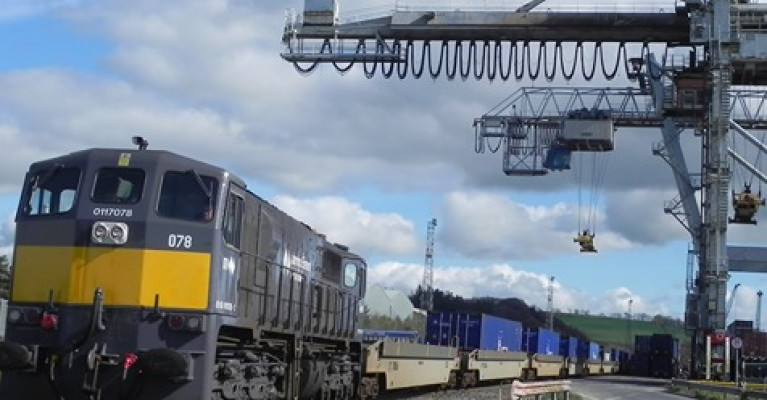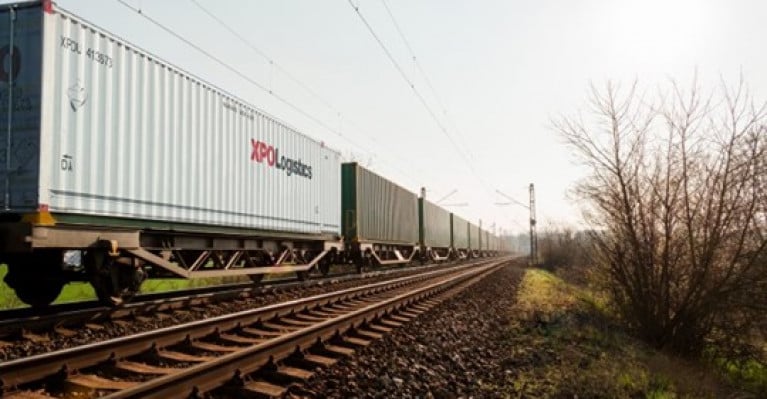Displaying items by tag: Railfreight
A weekly container train between Ballina and Belview Port, Waterford in July 2021 was launched by XPO Logistics for onward shipping connections to mainland Europe.
Loadings on the new service reports Multimodal UK, were initially a little sporadic due to reduced output from the anchor customer and the effects of delays in Europe.
With the start-up issues being resolved from the start of 2022, service utilization began to increase and other customers began to use the XPO service for small volume movements of containers. The build-up of business has now reached sufficient volume level where a second weekly return service can commence and this is scheduled to happen from June.
The service, although originally set up to connect Ireland and mainland Europe, is now attracting additional business with XPO now trialling 2 loads that originate from outside Europe.
Paul Hayes, Business Unit Director, XPO Logistics Europe said: “It was not the start we expected, but we have gained momentum quickly and have a successful rail flow that has grown.”
The Ballina freight yard in Co. Mayo, is the busiest in the country outside Dublin handling intermodal trains to Dublin and Waterford Ports and pulpwood trains to Waterford.
The Irish Rail ‘Rail Freight 2040 Strategy’ notes the terminal as the model for new ‘Tactical Rail Freight Terminals’ (TRFT) that it proposes for construction in Cork, Galway and Sligo.
Rail-Freight Service Set to Boost Ballina's Busy Business Via (Belview) the Port of Waterford
RailSail: Details of a proposed new service were outlined by XPO Logistics at the latest Irish Exporters Association Western Council roundtable webinar.
As Western People reports, Ballina Beverages – which is a long-standing client of XPO Logistics – will be the main user of the proposed new sustainable service which will help transport the company’s soft drinks concentrate to global markets.
Ballina Beverages prioritises eco-friendly logistics and rail freight is the ideal solution for its transport requirements in that respect.
Through XPO, the freight movement from Ballina to (Belview) the port of Waterford will then be transferred to Rotterdam Port by ferry and further multi-modal transport to world markets.
XPO has been working on the new freight project with Irish Rail since arriving in Ireland.
More on this development here.
#DublinSnapShot - Making a fleeting visit to Dublin Port yesterday was Morgenster, at almost a century old the Dutch built twin masted sailing vessel berthed close to the East-Link Bridge, while today cruiseship Island Sky, transited the bridge to berth before the Samuel Beckett bridge, writes Jehan Ashmore.
Morgenster's North Wall Quay berth was opposite the O2 Arena (formerly The Point) and lest it not be forgotten the site of a large railway depot. In the surrounding compounds behind the entertainment venue remains laid-up Irish Rail InterCity rolling stock. These older generation rolling stock if you recall were liveried in striking orange, however days of further service are long gone as they are been dismantled.
The role of railways however are not completely redundant in Dublin Port, no were not talking of the lightrail LUAS link 'straight to the Point', but the established 'working' train traffic that been to Alexandra Basin (East). Here trains from Bolidan Tara Mines Co. Meath, are laden with deposits from Europe's largest zinc mines and containers by rail arrive and depart from Ballina, Co. Mayo.
As both rail-freight services terminate in the basin, the mined deposits are loaded onto bulkers, notably those frequent callers of the Arklow Shipping fleet, where today there were up to a trio of the distinctly green coloured hulled ships docked in port.
Firstly, Arklow Falcon which departed this afternoon having berthed along the bulk north quay and adjacent to where railway transported containers are hoisted on and off container vessels with destinations among them the Eastern Mediterranean and the African continent.
As for the remaining 'Arklow' pair, Arklow Manor is undergoing work in Dublin Dry Docks single dry-dock facility, next to the disused and in-filled older dry-dock. The historic dry-dock is to be excavated for heritage and tourism purposes as part of the €200m Alexandra Basin Redevelopment (ABR) Project in which Afloat.ie will have more 'revealing' details to uncover.
In addition Dublin Port are to find a new purpose for the former lightship 'Kittiwake' that local property developer Harry Crosbie had intended to use as a feature of the O2 Theatre Arena. Planning permission was refused by Dublin City Council.
The Kittiwake which is understood awaiting a survey, was subsequently purchased by the Dublin Port Company, who will decide her fate. What is certain her future role remains in the port and is intended to serve in an amenity role thus benefitting the public.
While the final member of the Arklow trio, the Arklow Brook is berthed outside the basin, alongside the Deepwater Berth, also known as the 'Coal' berth which is on the south bank of the channel.
It was at this quayside last Friday, that Irish Ferries, Epsilon, shifted opposite berths from the busy ferryport terminal having experienced 'technical' problems, which led to cancellation of all her sailings to Holyhead and last weekend's Dublin-Cherbourg round trip.
Epsilon's technical difficulties have been resolved as this afternnon she sailed to Holyhead.
She is seen pictured on our Cruise Liners coverage of Celebrity Infinity's arrival in the wake of Mein Schiff 1, which berthed earlier in Alexandra Basin. Celebrity Infinity was attended by tugs and Epsilon berthed in the backround while work to repair her gets underway.
As part of the ABR project there are plans for a dedicated cruise terminal which would cater for even larger cruiseships as those mentioned above.
The custom built terminal would be closer to the city-centre at a site near where our port snapshot had begun at the East-Link Bridge. Let the bridge lift be open again!... and to who knows what?
Big Plans for Rosslare Europort
Ambitious plans to introduce load-on load-off (Lo-Lo) facilities at Rosslare Europort have been announced, according to a report in yesterday's Wexford People.
However, to facilitate all these developments, Mr Lynch said they will need the reclamation of up to 20 hectares of additional land and the deepening of part, or all, of the port from the current 7.2m to 9m and perhaps, eventually, 11m.
Mr Lynch said these developments would be facilitated, and accelerated, by of a port centric logistics zone (a grouping of activities dealing with freight transportation) on lands beside the south-eastern port.
Mr Breen said he recognises the 'fundamental and strategic importance of Rosslare Europort to the economic development of the county'.
The county manager said he will recommend that 'appropriate policies, objectives and development management standards are included in the draft plan to facilitate the development of the port', subject to the appropriate technical and environmental assessments.
As part of his submission, Mr Lynch also requested that the '1902 Lighthouse' at the port, which is recognised on the National Inventory of Architectural Services, not be included on the Record of Protected Structures.
Mr Breen said he would give further consideration as to whether it would be appropriate to de-list the lighthouse in advance of the draft plan.
Next month the port will host the annual Irish Ports Conference in the Ferrycarrig Hotel, Wexford on Friday 30 September.
- Rosslare Europort
- Ports and Shipping News
- Irish Rail
- Iarnrod Eireann
- Ferry news
- Rosslare Harbour
- Irish Ports Conference
- Irish Ports Association
- Ferrycarrig Hotel
- Railfreight
- Port Development
- National Inventory of Architectural Services
- Record of Protected Structures
- Irish Lighthouses
- Lighthouses of Ireland news
New €1.5m Rail-Spur for Dublin Port
The minister welcomed "the important investment by Dublin Port Company in its rail network. It will further enhance the attractiveness of the port as a destination for rail-based freight. The project represents a commitment on the part of Dublin Port Company and Iarnród Éireann to customers who want to move goods by rail".
The project took six months to complete and the public private partnership involved Dublin Port Company, Iarnród Éireann and the first customer of the new facility, International Warehousing and Transport (IWT).
IWT is a privately owned Irish logistics company, which already operates freight-trains to Ballina that are expected to increase from 4 to 5 trains per week in each direction as a result of this investment. The rail-operator believes that the service will save up to 5.5million road kilometres annually and reduce CO2 emissions by up to 2,750 tonnes.
The Irish Exporters Association also welcomed the development of the IWT freight operation at the new facility, where increased frequency in services will enhance Ireland's contribution to the European Union's modal shift aspirations from road to rail.
The Common User Terminal is also open to other shipping companies. Existing clients using the lo-lo container terminal operated by Burke Shipping Group through its subsidiary Portroe Stevedores are C2C Lines, APL, Coastal Containers, Evergreen, Gracechurch and OOCL . The terminal also has a ro-ro berth facility where CLdN /Cobelfret operate from on routes to Belgium and The Netherlands.
In addition to the Dublin-Ballina service the port exports 400,000 tonnes of lead and zinc concentrate from the freight customers Boliden/Tara Mines with 15 trains per week. The facility at Alexandra Basin Jetty is regularly served by vessels from Arklow Shipping Ltd, where the 2011 newbuild Arklow Field (2,998 tonnes) is currently berthed.
- Dublin Port
- Dublin Port Company
- Arklow Shipping Ltd
- Irish Exporters Association
- Port of Dublin
- Ports and Shipping News
- IEA
- Minister for Transport
- Ocean Pier
- Irish Rail
- Iarnrod Eireann
- Portroe Stevedores
- Dublin Port news
- IWT
- ASL
- Leo Varadkar T.D.
- Port of Dublin news
- Railfreight
- International Warehousing and Transport
- Alexandra Basin East
- Common User Terminal
- Burke Shipping Group
- Clnd Cobelfret
- Boliden
- Tara Mines
- Arklow Field
- Dublin Shipping
- Lead mines
- Zinc mines
- Irish Railways
- Dublin Port railhead



























